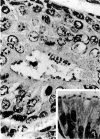The evolution of respiratory Cryptosporidiosis: evidence for transmission by inhalation
- PMID: 24982322
- PMCID: PMC4135895
- DOI: 10.1128/CMR.00115-13
The evolution of respiratory Cryptosporidiosis: evidence for transmission by inhalation
Abstract
The protozoan parasite Cryptosporidium infects all major vertebrate groups and causes significant diarrhea in humans, with a spectrum of diseases ranging from asymptomatic to life-threatening. Children and immunodeficient individuals are disproportionately affected, especially in developing countries, where cryptosporidiosis contributes substantially to morbidity and mortality in preschool-age children. Despite the enormous disease burden from cryptosporidiosis, no antiprotozoal agent or vaccine exists for effective treatment or prevention. Cryptosporidiosis involving the respiratory tract has been described for avian species and mammals, including immunocompromised humans. Recent evidence indicates that respiratory cryptosporidiosis may occur commonly in immunocompetent children with cryptosporidial diarrhea and unexplained cough. Findings from animal models, human case reports, and a few epidemiological studies suggest that Cryptosporidium may be transmitted via respiratory secretions, in addition to the more recognized fecal-oral route. It is postulated that transmission of Cryptosporidium oocysts may occur by inhalation of aerosolized droplets or by contact with fomites contaminated by coughing. Delineating the role of the respiratory tract in disease transmission may provide necessary evidence to establish further guidelines for prevention of cryptosporidiosis.
Copyright © 2014, American Society for Microbiology. All Rights Reserved.
Figures






References
-
- Kotloff KL, Nataro JP, Blackwelder WC, Nasrin D, Farag TH, Panchalingam S, Wu Y, Sow SO, Sur D, Breiman RF, Faruque AS, Zaidi AK, Saha D, Alonso PL, Tamboura B, Sanogo D, Onwuchekwa U, Manna B, Ramamurthy T, Kanungo S, Ochieng JB, Omore R, Oundo JO, Hossain A, Das SK, Ahmed S, Qureshi S, Quadri F, Adegbola RA, Antonio M, Hossain MJ, Akinsola A, Mandomando I, Nhampossa T, Acacio S, Biswas K, O'Reilly CE, Mintz ED, Berkeley LY, Muhsen K, Sommerfelt H, Robins-Browne RM, Levine MM. 2013. Burden and aetiology of diarrhoeal disease in infants and young children in developing countries (the Global Enteric Multicenter Study, GEMS): a prospective, case-control study. Lancet 382:209–222. 10.1016/S0140-6736(13)60844-2 - DOI - PubMed
-
- Nasrin D, Wu Y, Blackwelder WC, Farag TH, Saha D, Sow SO, Alonso PL, Breiman RF, Sur D, Faruque AS, Zaidi AK, Biswas K, Van Eijk AM, Walker DG, Levine MM, Kotloff KL. 2013. Health care seeking for childhood diarrhea in developing countries: evidence from seven sites in Africa and Asia. Am. J. Trop. Med. Hyg. 89(Suppl 1):3–12. 10.4269/ajtmh.12-0749 - DOI - PMC - PubMed
-
- Sallon S, el-Shawwa R, Khalil M, Ginsburg G, el Tayib J, el-Eila J, Green V, Hart CA. 1994. Diarrhoeal disease in children in Gaza. Ann. Trop. Med. Parasitol. 88:175–182 - PubMed
-
- Adjei AA, Armah H, Rodrigues O, Renner L, Borketey P, Ayeh-Kumi P, Adiku T, Sifah E, Lartey M. 2004. Cryptosporidium spp., a frequent cause of diarrhea among children at the Korle-Bu Teaching Hospital, Accra, Ghana. Jpn. J. Infect. Dis. 57:216–219 http://www0.nih.go.jp/JJID/57/216.html - PubMed
-
- Sallon S, Deckelbaum RJ, Schmid II, Harlap S, Baras M, Spira DT. 1988. Cryptosporidium, malnutrition, and chronic diarrhea in children. Am. J. Dis. Child. 142:312–315 - PubMed
Publication types
MeSH terms
LinkOut - more resources
Full Text Sources
Other Literature Sources
Medical

